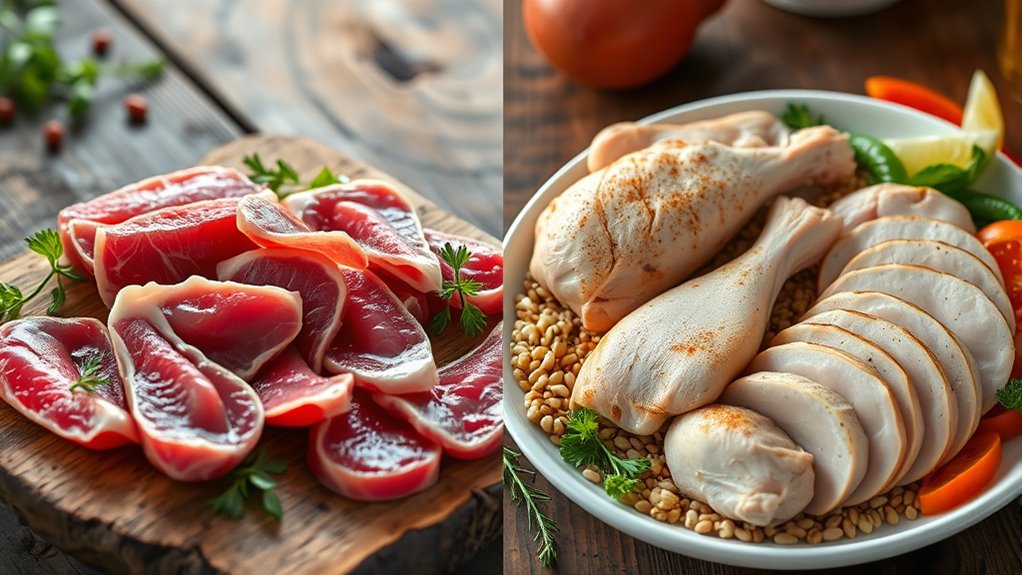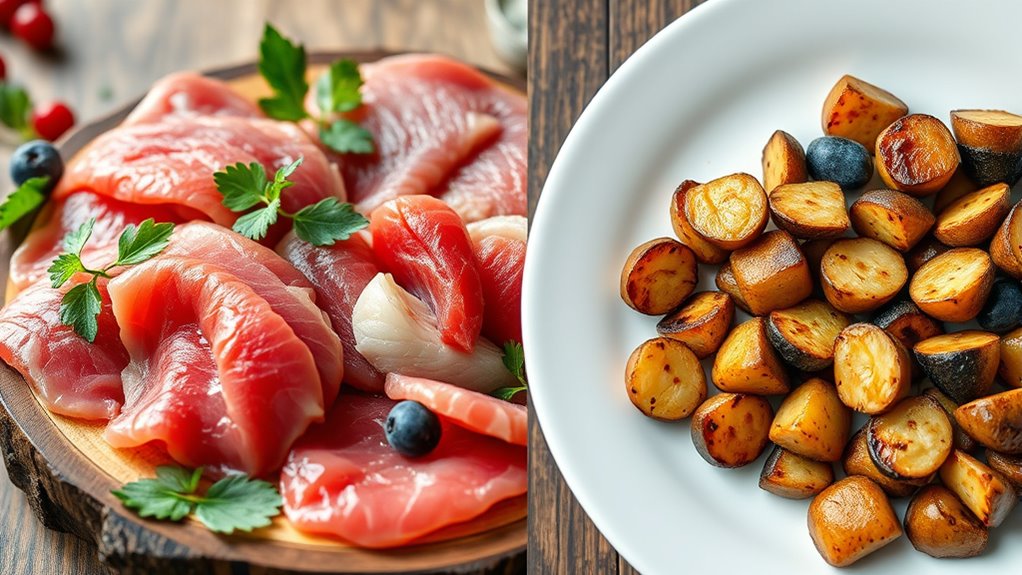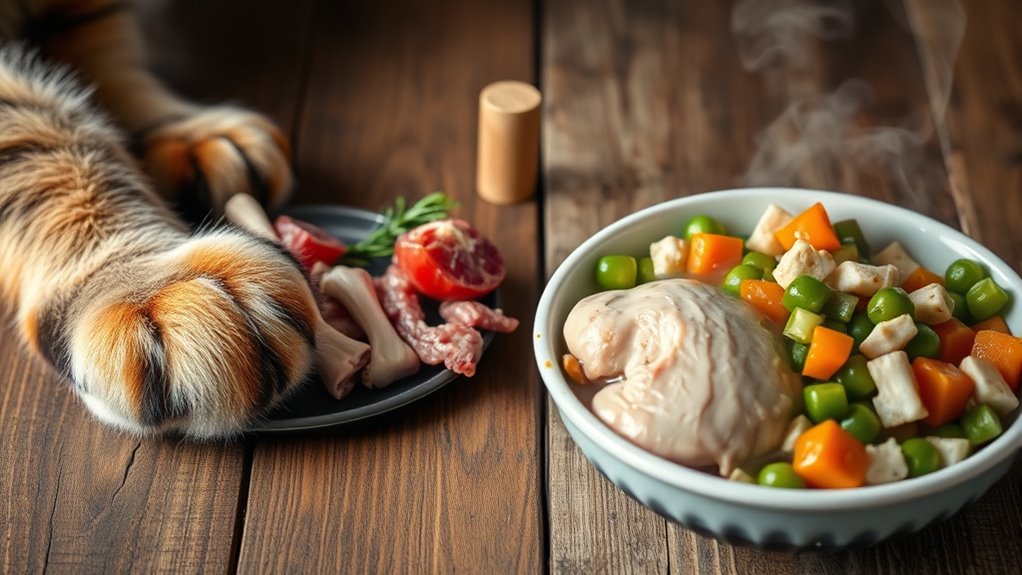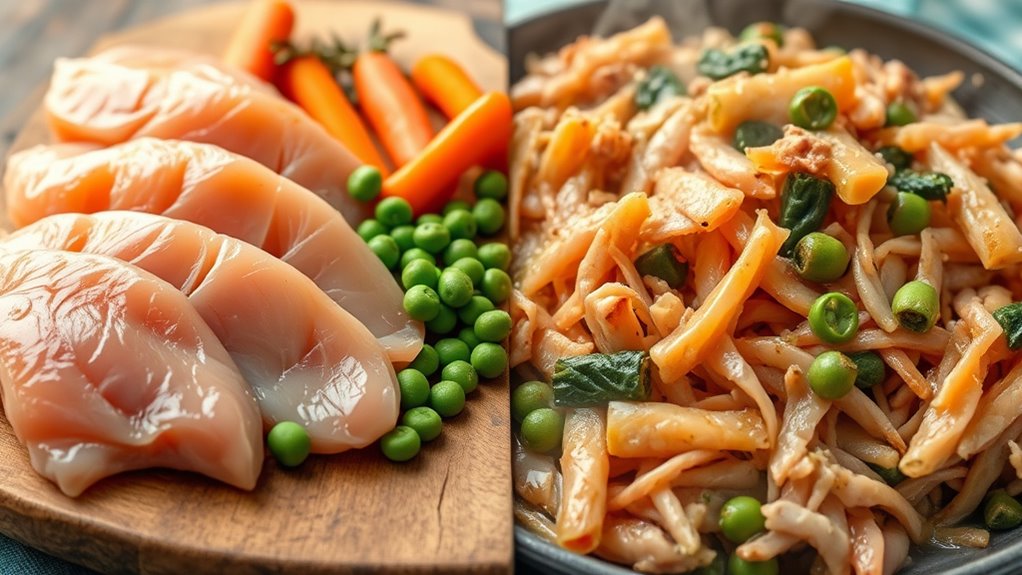Choosing between raw and cooked diets for your cat depends on their needs and your preferences. Raw diets mimic natural hunting instincts, potentially offering better digestion, shinier coat, and more energy, but they carry risks like bacterial contamination and parasites if not handled properly. Cooked diets are safer and easier to digest, reducing health concerns. To make an informed decision that supports your cat’s health, explore the detailed facts behind each option.
Key Takeaways
- Raw diets preserve natural enzymes and nutrients, potentially improving coat health and digestion, but carry risks of bacterial and parasitic contamination.
- Cooked diets reduce bacterial and parasite risks, making them safer while still providing essential nutrients for feline health.
- Both diet types require careful planning and supplementation to prevent nutritional deficiencies and ensure complete nutrition.
- The choice depends on individual cat health, preferences, and lifestyle, with consultation from a veterinarian recommended.
- High-quality, organic ingredients enhance both raw and cooked diets, supporting overall feline health and long-term well-being.
Understanding the Natural Diet of Cats

To truly understand the natural diet of cats, it’s important to recognize that they are obligate carnivores, meaning their bodies are designed to thrive on meat-based nutrients. In the wild, feline behavior centers around hunting small animals like rodents and birds, which provides them with essential proteins and fats. This natural hunting instinct influences their dietary needs, regardless of whether they live indoors or outdoors. Outdoor cats have the opportunity to hunt, mimicking their wild behavior, while indoor cats rely on owners to provide appropriate nutrition. Understanding this natural hunting drive helps you appreciate why a diet rich in high-quality meat is crucial, whether you’re feeding a free-roaming or indoor cat. It highlights the importance of replicating their natural diet for excellent health. Recognizing their hunting instincts can guide better nutritional choices that support their overall well-being.
Benefits of Raw Diets for Feline Health

Raw diets can offer several health benefits for cats by closely mimicking their natural eating habits. One key advantage is the preservation of feline digestive enzymes, which are often destroyed during cooking. These enzymes help cats digest food more efficiently and absorb nutrients better. Additionally, raw diets can lead to healthier skin and a shinier coat, thanks to the natural nutrients retained in raw meat. When it comes to meal preparation techniques, you’ll find that minimal processing helps maintain nutrient integrity. Feeding raw allows you to tailor meals to your cat’s specific needs and preferences. Overall, a raw diet supports better digestion, increased energy levels, and improved overall health by aligning with your cat’s evolutionary dietary requirements. Incorporating proper nutrition practices is essential to ensure your feline’s diet remains balanced and safe.
Potential Risks Associated With Raw Feeding

While raw diets can benefit cats, they also pose certain health risks if not handled properly. One major concern is toxoplasmosis transmission, which can occur if contaminated raw meat isn’t managed carefully. Cats fed raw diets are also at risk of parasite exposure, including bacteria like Salmonella and E. coli, which can cause illness in both cats and humans. Handling raw meat improperly increases the chance of cross-contamination in your home. Additionally, inconsistent sourcing of ingredients may introduce harmful pathogens. Without proper hygiene and storage, your cat’s health could be compromised, and there’s a risk to your own health as well. Being aware of these potential dangers helps you make informed decisions about raw feeding and implement strict safety measures. Monitoring Bitcoin IRA market trends can also help in making better investment choices related to your financial health.
Advantages of Cooked Diets for Cats

Cooking your cat’s food offers several key advantages, primarily enhancing safety by reducing the risk of harmful pathogens. The cooking benefits include making proteins easier to digest, which supports your cat’s digestive health. Additionally, cooked diets help eliminate bacteria and parasites that could cause illness. Here are three main advantages: 1. Improved safety by killing bacteria and parasites 2. Easier digestion, reducing gastrointestinal issues 3. Increased palatability for some cats, encouraging better eating habits Proper food preparation methods ensure that cooking is done safely and effectively.
Ensuring Nutritional Balance in Cooked Meals

Ensuring your cat’s cooked meals are nutritionally complete requires careful planning. You need to focus on ingredient sourcing, choosing high-quality, fresh ingredients to meet your cat’s dietary needs. Incorporate a variety of protein sources, vegetables, and supplements to guarantee balanced nutrition. Proper meal preparation is essential; avoid overcooking ingredients to preserve nutrients and prevent nutrient loss. Use reliable recipes or consult a veterinary nutritionist to formulate meals that include essential vitamins and minerals, such as taurine and calcium. Additionally, selecting Vet-approved recipes can help ensure nutritional adequacy. Consistency in ingredient sourcing and precise meal prep help prevent nutritional gaps. Regularly monitor your cat’s health and adjust recipes if needed. By paying close attention to these factors, you can create cooked meals that support your cat’s overall health and well-being.
Safety Considerations for Raw and Cooked Options

You need to be aware of bacterial contamination risks with both raw and cooked diets, as improper handling can make your cat sick. Following proper food safety practices helps minimize these dangers. Keep in mind that nutritional imbalances can also arise if the diet isn’t carefully managed. Regularly monitoring air quality indicators can help ensure a safe environment for your pet.
Bacterial Contamination Risks
Raw diets pose a higher risk of bacterial contamination, which can threaten both your cat’s health and your household safety. Bacterial contamination in raw foods can introduce pathogens like Salmonella or E. coli, risking infection for your cat and humans. To protect food safety, consider these key points:
- Raw meat may harbor harmful bacteria even if it looks clean.
- Proper storage and refrigeration are essential to inhibit bacterial growth.
- Cross-contamination can occur if raw foods contact surfaces or other foods.
While cooking kills most bacteria, raw diets require strict handling to minimize risks. Being aware of bacterial contamination helps you make informed decisions about your cat’s diet and maintain a safe environment. Proper hygiene and vigilance are essential for managing food safety with raw feeding.
Proper Food Handling Practices
Proper food handling practices are crucial for minimizing health risks associated with both raw and cooked diets. You should establish consistent feeding schedules to prevent overeating or food spoilage. Always store food properly: raw ingredients need refrigeration at or below 40°F, and cooked leftovers should be discarded after a few days. Use separate cutting boards and utensils for raw meat to avoid cross-contamination. Wash your hands thoroughly before and after preparing meals. When storing, keep raw and cooked foods separate to maintain freshness and safety. Ensure your cat’s food is served at appropriate temperatures, and never leave food out for extended periods. Maintaining a clean environment and practicing proper food safety techniques helps protect your feline’s health and reduces the risk of bacterial transfer.
Risk of Nutritional Imbalance
While both raw and cooked diets can provide essential nutrients, they also pose risks of nutritional imbalance if not carefully planned. Without proper oversight, your cat may develop nutritional deficiencies that impact their health. To prevent this, you should focus on:
- Ensuring balanced meals with all necessary nutrients.
- Incorporating dietary supplementation when gaps are identified.
- Regularly consulting with a veterinarian or feline nutritionist.
- Paying attention to authentic materials and their role in creating a balanced diet for optimal health.
Raw diets often lack certain vitamins or minerals, requiring careful supplementation, while cooked diets can lose some nutrients during processing. Both options demand precise planning to avoid deficiencies that could cause health issues. By paying close attention to dietary balance and supplementation, you can help maintain your cat’s well-being and prevent long-term nutritional problems.
Making an Informed Choice for Your Cat’s Well-Being

Choosing the right diet for your cat involves more than just picking between raw and cooked options; it requires careful consideration of your cat’s unique health needs, lifestyle, and preferences. To make an informed choice, assess how often you feed your cat—whether daily, multiple times a day, or intermittently—and how that impacts their nutrition. Remember, both diets may require dietary supplements to ensure complete nutrition, especially if you’re leaning toward homemade or raw options. Consult your veterinarian to determine the best feeding frequency and supplements tailored to your cat’s age, health, and activity level. Additionally, understanding the importance of organic seed cultivation can help you incorporate high-quality, pesticide-free ingredients into your cat’s diet when preparing homemade meals or treats. By staying informed, you can create a balanced plan that promotes your cat’s overall well-being while aligning with your lifestyle.
Frequently Asked Questions
How Do Raw and Cooked Diets Affect a Cat’S Dental Health?
You might notice that raw diets can help reduce dental plaque because the texture often encourages chewing, which naturally cleans teeth. However, raw food risks bacteria that can cause infections. Cooked diets are softer, so they may contribute to enamel erosion over time, weakening your cat’s teeth. Both diets impact dental health differently, so regular vet checkups are essential to prevent issues like plaque buildup and enamel damage.
Can Switching Diets Improve a Cat’S Behavior or Energy Levels?
Switching diets can definitely influence your cat’s behavior modification and energy enhancement. You might notice increased alertness and playfulness when you choose a diet that suits their needs. Fresh, high-quality foods can boost vigor, while some diets may reduce lethargy. By observing their reactions, you can tailor their nutrition to help improve behavior and energy levels, making your feline friend more active and happier overall.
Are There Specific Age Groups Better Suited for Raw or Cooked Diets?
You might wonder if certain age groups benefit more from raw or cooked diets. For pediatric nutrition, raw diets can support growth, but you should consult your vet to guarantee safety. Seniors often need special attention to their dietary needs, so cooked diets might be easier to digest and manage. Always tailor your cat’s diet to their age, health, and specific requirements, and seek professional advice for the best approach.
How Do Diet Choices Impact a Cat’S Immune System?
Your diet markedly impacts your cat’s immune response and nutrient absorption. A balanced diet provides essential vitamins and minerals that strengthen immunity, helping fend off illnesses. Raw diets often preserve nutrients better, boosting immune response, but may carry risks if not properly prepared. Cooked diets can enhance safety and digestion. Ultimately, choosing a diet that supports ideal nutrient absorption and immune health benefits your cat’s overall well-being.
What Are the Long-Term Health Implications of Each Diet Type?
Think of your cat’s health as a garden that needs careful tending. Long-term, a balanced diet fosters vibrant growth, ensuring strong immune defenses and steady digestive health. Raw diets can offer natural nutrients but risk imbalance, while cooked diets provide safety and consistency. Each choice influences your feline’s future wellbeing, shaping their energy and resilience. Prioritizing nutritional balance helps your cat thrive over the years, much like nurturing a flourishing garden.
Conclusion
Choosing between raw and cooked diets for your cat is like tending a delicate garden—each option offers growth and risks. Raw diets can symbolize the raw, untamed spirit of nature, while cooked meals represent cultivated stability. Your decision shapes your feline’s future, nurturing their health like a gardener tending fragile blooms. Trust your instincts and knowledge to create a balanced, safe environment—ensuring your cat’s well-being blossoms, rooted in love and understanding.









